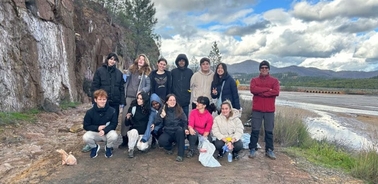Environmental Science for Sustainability Students Visit the Rio Tinto Mining District

The field trip exposed students to the issues and solutions of acid mine drainages through a hands-on-approach.
Students in the Bachelor of Environmental Sciences for Sustainability (BESS) participated in a field trip to the Rio Tinto Mining District to complement their courses in Geology, Fundamentals of Ecology, and Instrumental Analysis following the program’s project-based pedagogical approach.
The district, known for its world class Massive Volcanic Sulfides (MVS) suffers from several environmental issues due to centuries-long mining activities which the students discussed.
Juan Carlos Silva-Tamayo, Academic Director of the BESS said the students mainly explored acid mine drainages and learned what technologies to use for evaluating and mitigating the issue.
“We mainly discussed the generation of acid mine drainages and the technologies that should be used to evaluate their impacts and mitigate them,” he said. “An example is the use of bacterias and bioaccumulating plants that can clean up the surface waters and be used to concentrate and produce new raw metals for the energy transition.”
Ben Stoltzman, a student in the BESS said he was optimistic to learn about nature-based solutions during the trip.
“I was amazed to learn that some of the smallest microorganisms as well as native plant species are capable of recovering these mines sustainably,” Stoltzman said. “This gives me hope that large scale mining operations needed for the green energy transition can be managed effectively using nature based solutions.”
The students also received hands-on-training in instrumentation and environmental sampling techniques to collect field data, then write executive research reports.
“Students learned how to use portable geolocation systems connected to specialized mobile applications. This allowed them to register all the necessary field information, as well as collect and register the environmental samples to be analyzed later in the labs,” Silva-Tamayo said. “All the field information will allow them to generate executive reports of their field activities and interpret the data from an environmental point of view.”
Silva-Tamayo said the district serves as an analogue for potential life on Mars due to its similar acidic and anoxic waters which only special microorganisms can survive. Professor Irene Sanchez has been working several years on this topic.
“The highly acidic and anoxic waters of the Rio tinto river are extreme environments which only allow the occurrence of very specialized microorganisms,” he explained. “Their adaptation to those extreme conditions, which are similar to the ones that one might expect on the Mars surface, can give us a clue about the potential forms of life that occur on the red planet.”
